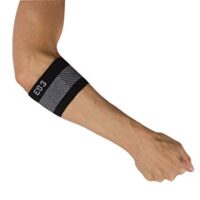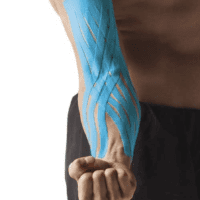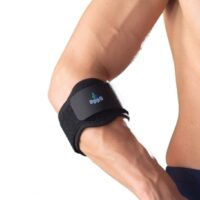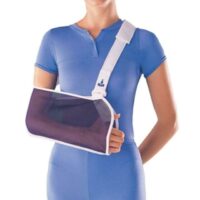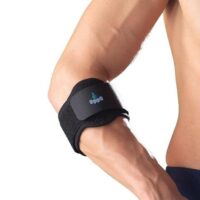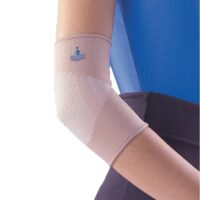Tennis Elbow
Article by John Miller


Tennis Elbow
Lateral Epicondylalgia
Tennis elbow, medically known as lateral epicondylalgia, stems from overusing the forearm’s muscles and tendons, causing pain on the elbow’s outer part. Symptoms exacerbate during gripping tasks or when extending the wrist and fingers against resistance. Wrist muscle trigger points often accompany this condition. Tennis elbow is the most common source of elbow pain. A similar condition known as golfers elbow is experienced on the inside of the elbow near your “funny bone”.
The Root Causes
Acute tennis elbow arises from excessive use and inadequate rest. In contrast, chronic cases often relate to the tendons’ degenerative changes near the elbow, resulting in ongoing pain and weakness in the elbow and hand. Muscle imbalances in the forearm might also be a contributing factor.
Early Intervention: Why It’s Essential
Addressing tennis elbow early on with a physiotherapist’s guidance is crucial. They can pinpoint the cause, craft a customised treatment plan, and help prevent further damage. Act promptly to avoid worsening symptoms.
Diagnosis: More Than Just an Examination
An accurate diagnosis goes beyond physical assessment and might include ultrasound or MRI scans to identify tendon damage. It’s critical to differentiate tennis elbow from neck-related pain, which requires a comprehensive neurodynamic assessment.
Who’s at Risk?
Tennis elbow doesn’t discriminate, affecting all ages and genders. Yet, individuals in repetitive manual work or sports are at greater risk. It’s not just tennis players; plumbers, painters, and builders are also prone, with a notable prevalence in those aged 30 to 50.

Prognosis: The Light at the End of the Tunnel
While tennis elbow can linger for months or even years if neglected, timely and proper treatment can lead to full recovery, often much quicker.
The Role of Physiotherapy
Physiotherapy stands out as a highly effective approach, with patients often seeing significant improvement within weeks. Though quick fixes like cortisone shots can seem appealing, they may hinder long-term healing. Physiotherapy remains the cornerstone for sustainable recovery.
Bracing for Support
A tennis elbow brace can alleviate mild symptoms and fend off recurrence during repetitive activities. However, if pain persists, it’s imperative to consult a physiotherapist for a detailed evaluation and tailored treatment plan. Read more: How Does a Tennis Elbow Brace Help?
Comparing Injection Effectiveness
Researchers are constantly comparing corticosteroid and other injections versus physiotherapy, counterforce bracing and placebo approaches with interesting results for both immediate relief and long-term recovery.
Read more here: Tennis Elbow Treatment: Immediate Relief vs Long-Term
Conclusion: Embrace Professional Care
Physiotherapy unlocks the door to effective tennis elbow management through tailored treatment strategies, including exercises, mobilisations, and supportive braces. Significant improvement is achievable within weeks, yet without treatment, discomfort can drag on for years. Don’t let tennis elbow rule your life—consult a physiotherapist and embark on your journey to recovery today.
Professional Perspective: Keeping Up with Current Research
Recent research advocates for the benefits of physiotherapy, with some studies highlighting the success of specific strengthening exercises targeting the affected tendons.
It’s important to stay informed about the latest developments and discuss these with a physiotherapist to enhance treatment efficacy. Always seek professional advice for a tailored approach and the best outcome.
Related Articles
- Golfer’s Elbow (Medial Epicondylitis): Readers will learn about a condition similar to tennis elbow but affecting the inside of the elbow. This article explains symptoms, causes, and treatment options for golfer’s elbow, providing insight into another common elbow issue.
- Elbow Pain: This page offers a broad overview of various causes of elbow pain, including tennis elbow, and discusses different diagnostic and treatment approaches. It’s useful for readers looking to understand elbow pain more comprehensively.
- Wrist Pain: Given that tennis elbow can exacerbate during gripping tasks or when extending the wrist and fingers against resistance, this article provides valuable information on managing wrist pain, which may accompany or result from tennis elbow.
- Tennis Elbow Brace: An article dedicated to explaining how a tennis elbow brace can help alleviate symptoms and prevent recurrence during repetitive activities. It complements the brief mention in the original article, offering detailed insights into the use and benefits of elbow braces.
- Corticosteroid Injections for Elbow Pain: This article evaluates the use of corticosteroid injections in managing elbow pain, including tennis elbow, comparing its effectiveness with other treatment options like physiotherapy.
Elbow Pain Causes, Diagnosis, and Effective Physiotherapy Management
Introduction
Elbow pain, a common ailment affecting people of all ages, can disrupt daily activities and diminish quality of life. This article, informed by physiotherapist insights, explores the various causes of elbow pain, emphasising the importance of early diagnosis, accurate assessment, and tailored physiotherapy interventions.
Understanding Elbow Pain
Elbow pain can stem from various sources, ranging from tendinopathy to nerve compression. Identifying the root cause is key to selecting the most effective treatment.


Common Elbow Pain Causes
Tennis Elbow and Golfer's Elbow:
Tennis Elbow and Golfer's Elbow, caused by overuse or strain of the elbow tendons, are prevalent among athletes and those engaging in repetitive arm movements. More info: Tennis Elbow, Golfer Elbow.
Olecranon Bursitis:
Olecranon Bursitis is inflammation of the bursa near the elbow joint leads to pain and swelling.
Youth Elbow Pain:
Conditions like Thrower's Elbow and Little League Elbow are common in young athletes due to repetitive stress. More info: Youth Arm Pain
Neck-Related Arm Pain:
Issues in the neck, like Cervical Radiculopathy or Neck Arm Syndrome can manifest as elbow pain.
Muscle-Related Pain:
Muscle strains and repetitive strain injuries (RSI) often present as elbow discomfort.
Medical Conditions:
Stress fractures, fibromyalgia, and various types of arthritis can also lead to elbow pain.
Recent Research Insights
Recent studies highlight the effectiveness of targeted physiotherapy in treating elbow pain. Techniques such as manual therapy, specific exercises, and other therapies have shown promising results in reducing pain and improving function.
The Role of Physiotherapy in Treating Elbow Pain
Physiotherapy plays a crucial role in the management of elbow pain, focusing on alleviating discomfort and restoring normal function.
Key Physiotherapy Interventions
- Personalised Exercise Programs: Tailored exercises to strengthen and stretch the affected muscles.
- Manual Therapy: Hands-on techniques to improve joint mobility and reduce pain.
- Pain Management: Use of modalities like ice, heat, and ultrasound to manage pain and inflammation.
- Education and Advice: Guidance on activity modification and ergonomics to prevent recurrence.
The Importance of Early Intervention
Early physiotherapy intervention can prevent the progression of symptoms and facilitate a quicker return to daily activities.
When to Seek Professional Advice
Consult a physiotherapist or doctor if you experience persistent or worsening elbow pain. They can conduct a comprehensive assessment and develop a personalised treatment plan.
What to Do?
If you're experiencing elbow pain:
- Rest: Avoid activities that exacerbate the pain.
- Apply Ice: To reduce swelling and pain.
- Seek Professional Help: A physiotherapist can provide expert advice and treatment.
Conclusion
Elbow pain, though common, can be effectively managed with physiotherapy. Understanding the cause, seeking early treatment, and adhering to a personalised care plan are vital for a successful recovery.
For more detailed information on elbow pain causes and treatments, visit PhysioWorks, where you can find resources and professional advice tailored to your condition.
Article by John Miller
Tennis Elbow Brace
Your Guide to Pain Relief and Recovery
Tennis Elbow Braces: A Physiotherapist's Guide
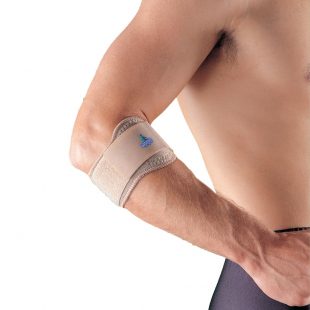

What is a Tennis Elbow Brace?
A tennis elbow brace offers vital support to an injured elbow, aiding in the healing process. It works by shifting the forces away from the affected elbow area, alleviating pain, and providing protection.
Does a Tennis Elbow Brace Offer Immediate Pain Relief?
Many individuals experience immediate pain relief with a tennis elbow brace, allowing a return to normal activities. However, if pain persists, it's essential to consult a physiotherapist for a thorough assessment and treatment plan.
How to Use a Tennis Elbow Brace Effectively
For optimal effectiveness, position the brace around the widest part of your forearm, especially during activities that trigger pain. This placement helps reduce pain and strengthen grip for those suffering from tennis or golfers elbow.
Further Reading and Resources
- Elbow-Related Arm Pain
- Tennis Elbow
- Golfers Elbow
- Olecranon Bursitis
- Juvenile Osteochondritis Dissecans
- Cervical Radiculopathy
- Neck Arm Pain
Conclusion
Embracing a tennis elbow brace as part of your recovery regimen can significantly aid in the healing process. Remember, consulting a physiotherapist for tailored advice is crucial for a successful recovery journey.





